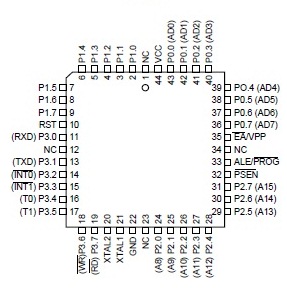 Description
Description
The AT90S2313 is a low-power CMOS 8-bit microcontroller based on the AVR RISC architecture. By executing powerful instructions in a single clock cycle, the AT90S2313 achieves throughputs approaching 1 MIPS per MHz allowing the system designer to optimize power consumption versus processing speed.
The AVR core combines a rich instruction set with 32 general purpose working registers. All the 32 registers are directly connected to the Arithmetic Logic Unit (ALU), allowing two independent registers to be accessed in one single instruction executed in one clock cycle. The resulting architecture is more code efficient while achieving through puts up to ten times faster than conventional CISC micro controllers.
The AT90S2313 provides the following features: 2K bytes of In-System Programmable Flash, 128bytes EEPROM, 128 bytes SRAM, 15 general purpose I/O lines, 32 general purpose working registers, flexible Timer/Counters with compare modes, internal and external interrupts, a programmable serial UART, programmable Watchdog Timer with internal Oscillator, an SPI serial port for Flash memory downloading and two software selectable power-saving modes. The Idle mode stops the CPU while allowing the SRAM, Timer/Counters, SPI port and interrupt system to continue functioning. The Power-down mode saves the register contents but freezes the Oscillator, disabling all other chip functions until the next external interrupt or Hardware Reset.
The device is manufactured using Atmel’s high-density non-volatile memory technology. The On-chip In-System Programmable Flash allows the Program memory to be reprogrammed in-system through an SPI serial interface or by a conventional non-volatile memory programmer. By combining an enhanced RISC 8-bit CPU with In-System Programmable Flash on a monolithic chip, the Atmel AT90S2313 is a powerful microcontroller that provides a highly flexible and cost-effective solution to many embedded control applications.
The AT90S2313 AVR is supported with a full suite of program and system development tools including: C compilers, macro assemblers, program debugger/simulators, In-Circuit Emulators and evaluation kits.
Features
- Utilizes the AVR ® RISC Architecture
- AVR High Performance and Low Power RISC Architecture
- 118 Powerful Instructions
- Most Single Clock Cycle Execution
- 32 x 8 General Purpose Working Registers
- Up to 10 MIPS Throughput at 10 MHz
- Data and Non-volatile Program Memory
- 2K Bytes of In-System Programmable Flash Endurance 1,000 Write/Erase Cycles
- 128 Bytes of SRAM
- 128 Bytes of In-System Programmable EEPROM Endurance: 100,000 Write/Erase Cycles
- Programming Lock for Flash Program and EEPROM Data Security
- One 8-bit Timer/Counter with Separate Prescaler
- One 16-bit Timer/Counter with Separate Prescaler, Compare, Capture Modes and 8, 9, or 10 bit PWM
- On-chip Analog Comparator
- Programmable Watchdog Timer with On-chip Oscillator
- SPI Serial Interface for In-System Programming
- Full Duplex UART
- Special Micro controller Features
- Low Power Idle and Power-down Modes
- External and Internal Interrupt Sources
- Low-power, High-speed CMOS Process Technology
- Fully Static Operation
- Power Consumption at 4 MHz, 3V, 25°C
- Active: 2.8 mA
- Idle Mode: 0.8 mA
- Power-down Mode: <1 µA
- 15 Programmable I/O Lines
- 20-pin PDIP and SOIC
- 2.7 - 6.0V (AT90S2313-4)
- 4.0 - 6.0V (AT90S2313-10)
- 0 - 4 MHz (AT90S2313-4)
- 0 - 10 MHz (AT90S2313-10)
Pin Configuration
Download Datasheet AT90S2313
































